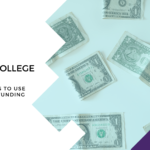Two temporary lifeline programs to help federal student loan borrowers transition into repayment after the COVID-19 payment pause are coming to an end September 30th. The on-ramp period allowed individuals to avoid the consequences of not making payments. The Fresh-Start initiative allowed borrowers to get their loans out of default quickly, even if they’ve already defaulted and entered repayment in the past.
If you’ve been making your student loan payments and are not delinquent, the end of the on-ramp period and Fresh-Start initiative won’t impact you.
What happened during the on-ramp period?
During the on-ramp period, loan servicers automatically placed student loans in forbearance when borrowers missed payments, which kept the loans from becoming delinquent. Federal student loans are normally considered delinquent the first day after a payment is missed and will default after 270 days (around 9 months) without payment.
Borrowers are protected from some of the more damaging consequences of missed payments, but the on-ramp period has its limitations. Interest accrues during forbearance which may lead to higher payments in the future. Forbearance on Direct loans is limited to 36 total months, so borrowers need to find an affordable repayment plan going forward.
How does the Fresh-Start initiative work?
The Fresh Start initiative offers a fast, accessible alternative to the traditional default resolution options. When a federal student loan defaults, borrowers typically have three options for resolving the default:
- Paying the loan in full
- Loan rehabilitation
- Loan consolidation
Not all borrowers can access these options. For example, if you’ve already consolidated your loans into a Direct Consolidation Loan, you won’t be able to consolidate to get out of default without another loan to consolidate.
Until September 30th, borrowers with defaulted student loans have the option to request the Fresh Start program online, by phone, or by mail. It’s the most efficient approach to resolving student loan default, and borrowers can expect to see their loans back in good standing within 4-6 weeks.
Consequences of delinquency and default
With federal student loans, a loan is typically reported as delinquent to the credit bureaus once it falls 90 days past due. This negative notation can remain on your credit report for up to seven years and can make it difficult to secure other forms of credit in the future.
Most federal student loans will default after 270 days without a payment. The repercussions of default can be severe and long-lasting.
When a federal student loan defaults:
- Your entire balance becomes due immediately, and you lose eligibility for federal repayment plans, deferment and forbearance
- The default is reported to the credit bureaus, and this negative mark can remain on your credit report for up to seven years
- Your tax refunds may be withheld automatically to repay your defaulted student loan
- Your paychecks could be garnished (up to 15% of your take-home pay) to be applied to your defaulted student loan
- Any Social Security benefits you receive could be offset to repay your defaulted student loan
- You become ineligible for additional federal student aid
- Your balance can continue to grow, as interest will continue to accrue after default
How will the end of these benefits impact borrowers?
Missed payments will be reported and loans will enter delinquent and default states.
If you miss a student loan payment after September 30th, your loan will no longer be placed in forbearance. Instead, your account will start to fall past due. You will need to take action to bring your account current, such as:
- Paying the past due amount
- Switching to a more affordable repayment plan
- Requesting general forbearance time (if available)
Forbearance is not a long-term solution and should only be used as a last resort after all other options have been explored. Forbearance can be granted for a short period – such as 30 days – or for an extended period of time – up to a maximum of 12 consecutive months. If your student loan remains in forbearance for an extended period of time, your balance will grow and your payment amount in the future may be higher, in order to pay off the larger balance within the time remaining in your loan term.
If your student loan defaults, it will be more challenging to resolve the default, with the end of the Fresh Start program. Borrowers will have to choose between loan consolidation or loan rehabilitation. Both options take longer to resolve default when compared to Fresh Start, and some borrowers may not qualify for both options.
If you consistently make student loan payments, there’s no change.
If you’ve been making your student loan payments on time, the end of the on-ramp period won’t have an impact on your loans. However, if you haven’t been making your student loan payments consistently, now is the time to explore your options to find a repayment strategy that works for you.
How should you prepare for the end of the on-ramp period and the Fresh Start program?
If you’re concerned about being able to afford your student loan payments once the on-ramp period ends, now is a great time to explore your repayment options.
Repayment options include:
- Income-driven repayment plans (SAVE, PAYE, IBR or ICR)
- Extended Repayment
- Loan forgiveness
- Consolidation
- Deferment and forbearance
If your loans are already in default, it’s not too late to get your loans back on track using the Fresh-Start Initiative before 9/30. If you’re reading this after 9/30 take a look at the rehabilitation and consolidation sections in this article How to Fix Defaulted Student Loans.
For Tuition.io members, if you have any questions about what this means for your loans, please reach out to a student loan coach at Tuition.io today. You can request an email or phone coaching session from the Student Loan Coaching tile on your Tuition.io dashboard.




